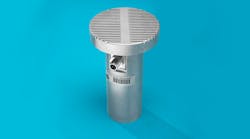Researchers at NASA have developed a form of microphone capable of perceiving infrasound waves below the range of human hearing, from 0.001 to 20.000 Hz, and capable of detecting suddenly occurring and potentially dangerous aeronautical turbulence many miles away. The unique microphone (see figure) may provide information on currently unknown environmental conditions such as clear-air turbulence and help change flight planning for safer air travel.
Clear-air turbulence is currently undetectable because there are no atmospheric features, such as clouds, to warn of these sudden events that can be so disruptive to aircraft in flight. Researchers Qamar Shams and Allan Zuckerwar at NASA’s Langley Research Center (Hampton, Va.) have experimented with the detection of clear-air turbulence since 2007, developing an infrasound signal for the events that could serve as warnings for air traffic controllers and aircraft pilots. As Shams explained, it would take a special microphone: “We have combined expertise in instrumentation, so why don’t we design a microphone ourselves?”
The sudden turbulence sometimes experienced when flying is called clear-air turbulence, so named because there are no visible clouds or atmospheric features to warn of the disruption. Turbulent invisible air can seemingly come out of nowhere and wreak havoc on aircraft. Though it is not easily detected visually, clear-air turbulence has a definite infrasound signature. Shams and Zuckerwar realized that if air traffic controllers or pilots could listen in on these whirling vortices before airplanes encounter them, an alternate route could be plotted.
Their experiments began in 2007, but, unsurprisingly, initial tests showed that they could not grab just any off-the-shelf microphone and expect it to work with infrasound. The long-wave frequencies tend to get overpowered by higher-frequency sounds, which results in interference.
“We found that the sensors get saturated, and they don’t perform well,” Shams said. “We thought, ‘We have combined expertise in instrumentation, so why don’t we design a microphone ourselves?’”
The researchers used a novel microphone design with a wide-radius, low-tension diaphragm, and a large, sealed air chamber behind it to allow the microphone to hear these sub-audio sound waves that travel such great distances. Manufactured by PCB Piezotronics under contract with NASA Langley, multiple infrasonic microphones were tested by placing them in an equidistant triangular pattern around the grounds of Langley’s runway. They could detect and identify atmospheric turbulence more than 300 miles away in skies above Pennsylvania.
The technology has developed with encouragement from the U.S. Department of Defense (DoD), Sandia National Laboratories, and Stratodynamics, Inc. (Lewes, Del.) also a developer of unmanned aerial vehicles (UAVs). After licensing patents from NASA, the company developed the microphone/sensor system for a stratospheric glider, the HiDRON, developed by Canadian affiliate Stratodynamics Aviation, Inc. The balloon-launched HiDRON glider has safely reached heights of more than 100,000 feet with the guidance of the infrasound microphone and wind probe. The company continues to work with NASA in using the infrasonic microphone to detect and identify the intensity and distance of unseen turbulent conditions.
